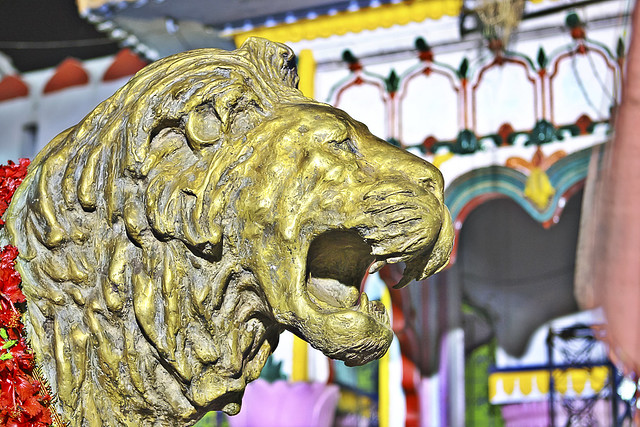Over the past couple of months, I have visited several old temples trying to capture the beautiful sculptures and artwork which has always been associated with ancient temples in India. And its just natural that I start with my native place Sambalpur.

Sambalpur has been named after its presiding deity Shree Shree Samaleswari. Samaleswari Temple is dedicated to the goddess, affectionately known as Maa Samalei. Maa means Mother in the local language. Maa Samaleswari has emerged as a strong religious force in western Odisha and Chhattisgarh states of India and has become the symbol of Sambalpuri culture.
The goddess has been worshipped on the bank of river Mahanadi since ancient times as Jagatjanani, Adishakti, Mahashakti and Bhuvaneshvari. The kingdom of Sambalpur was known as Hirakhanda in ancient times and had a rich cultural heritage. Ptolemy has described the place as Sambalaka on the left bank of river Manada, which is now known as Mahanadi. According to Jean-Baptiste Tavernier, a French traveller, and Edward Gibbon, an English historian, diamonds were exported to Rome from Sambalpur.

The temple was built in the 16th century by Balaram Dev who ruled Sambalpur sometime between 1540 AD and 1557 AD. It is built from a kind of stone as durable as granite and cemented with lime mortar. The whole building is plastered, but in the course of time the surface has become mouldy.
According to folklore, one day Balaram Dev crossed the river Mahanadi to go hunting with his hounds. While hunting, he noticed something strange. He saw his hounds running away for dear life. And chasing them was a rabbit. Balaram Dev was stunned. Later, he noticed the rabbit return to the foot of a huge Simili (cotton) tree on the left bank of Mahanadi. The same night, he had a strange dream. Goddess Samaleswari appeared in his dream and ordered him to establish her at the foot of the Simili tree and build a temple. The next morning Balaram Dev made up his mind and established his fort on the left bank of river Mahanadi. He installed the goddess Samaleswari under the Simili tree and built a temple. Sambalpur was a small village at that time. Some historians believe the idol of the goddess Samaleswari under the Simili tree was worshipped by tribals from the 3rd century A.D. until the temple was built by Balaram Dev.
In the late 16th century Kalapahad, the general of the King of Bengal, attacked Odisha and killed the last Hindu king, Gajapati Mukunda Dev. He ravaged some of the famous temples of Midnapore, the Khirachora Gopinath temple of Balasore, the Khiching temple of Mayurbhanj, Konark temple, Puri temple, the temples of Bhubaneswar, Jajpur and Cuttack. Then he attacked Sambalpur. The legend goes that Kalapahad was defeated due to Maa Samaleswari. Kalapahad's tomb and those of his soldiers could be seen on the outskirts of the city. But now the city has grown and the this little piece of history is lost.



Good pictures. Informative article. Story behind the temple is interesting.
ReplyDeleteThank you for visiting.
DeleteI love India's temples and statues. With the stories behind them they are even better. So beautiful.
ReplyDeleteYou can watch out for some future posts in which I will be posting more pictures from some of the most beautiful temples I have seen.
DeleteNice post and beautiful pics :)
ReplyDelete- Shanoj
Thank you for visiting!!
DeleteI did not know the history behind the establishment of Samaleswari temple ...by the way picture is very good..
ReplyDeleteNow you know the history!! Actually, the temple was closed by the time I reached the place. Else would have got some pictures from inside as well.
DeleteSo colorful!
ReplyDeleteNice snaps.
Deletegiftwithlove.com
Thank you Flip for stopping by. Most of the temples here are beautifully coloured.
DeleteThank you gwl for your comments.
DeleteNice one with good info...keep it coming
ReplyDeleteSo colorful!
DeleteThank you Burham for stopping by. I intend to make few more posts on temples in India. Have been visiting quite a few beautiful ones lately.
DeleteExcellent photographs, Remo. I enjoyed reading about the temple and its history. Your writing makes the photos come alive. Nice post, thank you. :)
ReplyDeleteThanks Vee. I never considered writing a strong point. Feels good that you liked reading through it :)
DeletePositive thoughts...
Deleteahmedabadonnet.com
Your pictures were wonderful, especially with the accompanying story. One thing that I have always found difficult is Indian history, with all its big and little empires, rajahs ranis, and foreign invaders - it all seems to me to be just a bit confusing. But you've done a masterful job, and I applaud you.
ReplyDeleteWow!! Coming from a writer, I feel I can give myself a pat on the back. Thank you for the encouraging words.
Deletegood documenting rambo :-)
ReplyDeleteOh well..It's my hometown dude!!
Deleteinteresting!
ReplyDeleteThank you!!
Deletelooks like a nice / beautiful temple!
ReplyDeleteYes. It's a nice place to spend some time in peace.
DeleteLovely, and fascinating!
ReplyDeleteThanks for the visit to my place, glad you enjoyed the hike! :o)
Thank you Chris for the visit.
Deleteultimate….
ReplyDeletepicturebite.com
amazingly captured
ReplyDeleteThanks Vandana for the kind words. Hope to see you here more often.
Delete